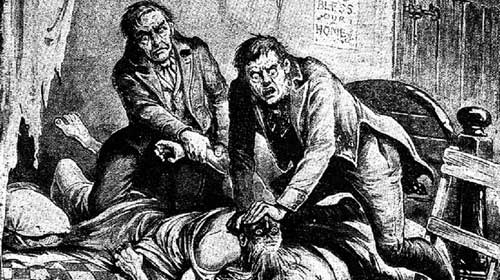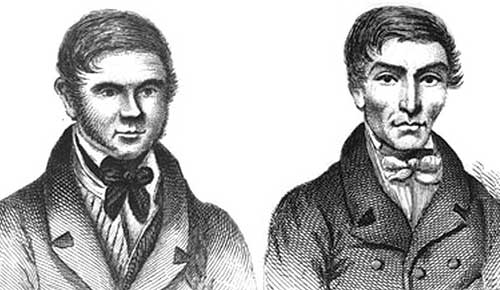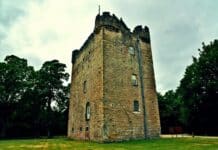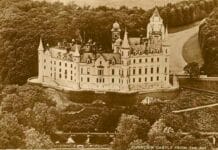MJ STEEL COLLINS tells us about those nasty Edinburgh bodysnatchers turned murderers Burke and Hare

“Up the close and doun the stair,
But and ben wi’ Burke and Hare.
Burke’s the butcher, Hare’s the thief,
Knox the boy that buys the beef.”
– 19th Century Edinburgh Children’s Song
Burke and Hare, notorious as the perpetrators of a series of murders in 1820s Edinburgh, have definitely left their mark on the Scottish psyche. Like Jack the Ripper, if you mention them, it’s more than likely the person you are talking to will have heard of them. It’s probably due to their links with Edinburgh anatomist Dr Robert Knox that Burke and Hare are often mistaken as Bodysnatchers, when in fact, they were two of the busiest serial killers on the British Isles.
In 1827 and 1828, when Burke and Hare were active, bodysnatching was big business. The Napoleonic Wars had driven up demand for army surgeons, resulting in huge hikes in the numbers of students at medical schools. There were 500 students in Edinburgh and Glasgow boasted similar numbers. Whilst students attended the anatomy schools at both Edinburgh and Glasgow Universities, a large number also attended a number of private schools, which had sprung up in both cities. In order to qualify as doctors, medical students were required to dissect at least one cadaver.
Something Of A Shortage
The only problem was that dead bodies were in short supply, the corpses of executed murderers being the only ones that were legally available for dissection. So the Resurrectionist trade sprung up. Bodies from all over the UK were sent to Edinburgh to meet demand. Anatomist Dr Robert Knox was a particularly keen consumer. He not only required bodies for his students to dissect, but needed them for his own research.

Burke and Hare, meanwhile, were Irish immigrants living in the West Port area of Edinburgh. Both shared the same first name of William. Hare saw to the day-to-day running of his partner Margaret Logue’s cheap lodging house in Tanners Close. Burke and his wife, Helen McDougal, came to lodge there. During their stay, another resident of the lodging house died, leaving a rent debt. Burke and Hare took the corpse off to Surgeon’s Square in Edinburgh, and sold it for £ 7 10 S to one of Dr Knox’s assistants. Quickly the pair realised there was money to be made.
The only problem was they decided that actually going into a cemetery and digging up bodies wasn’t worth the bother. Plus, the fresher a body was, the bigger the pay off, so murder it was to be. The lodging house provided a bountiful supply of bodies. A few tenants were to meet their maker by staying there. In all, Burke and Hare murdered 16 people between November 1827 and October 1828. Not all the names of the victims are known, perhaps because they came from the lower tiers of society. The preferred method of murder was suffocation as that left less marks on the body, increasing what the anatomists would pay.
Not Quite Getting Away With Murder
Burke and Hare’s partners were also in on the scheme. It’s unknown if they actually participated in any murder themselves. As time went on, Burke and Hare perhaps got somewhat complacent thanks to getting away with so many murders. The disappearance of some of their victims didn’t go unnoticed as they were quite well known in the area. Mary Paterson, or Mitchell, was a prostitute, with a reputation for being a great beauty. James Wilson, known as “Daft Jamie” was a popular local character, with family living nearby. Madgy Docherty was the final victim. And led to Burke and Hare’s undoing.
Two tenants, James and Ann Gray, in the lodging house became suspicious the night Madgy Docherty was murdered as they could hear signs of a struggle and someone yelling. The next day, Burke wouldn’t let Ann Gray collect her stockings from the bed where she had left them. She and her husband looked under the bed, and found Madgy Docherty’s body. The Grays alerted the police.
Ironic Justice
Burke, Hare, Margaret Logue and Helen McDougal were arrested and put on trial for murder. They were indicted for the murders of Mary Paterson, James Wilson and Madgy Docherty, though the other victims later became known of. The women were eventually released, and Hare turned on Burke, obtaining immunity from prosecution by appearing as a witness for the crown. At the end of the trial, Hare was free to go. Burke was hanged on 28 January 1829, and fittingly, his body was sent for dissection at the anatomy school. His skeleton is on display at the museum of Edinburgh’s Medical School.
A popular myth is that after the trial, Hare was attacked by a crowd and blinded. Whilst that’s not true, he and his family (he’d already had baby with Margaret Logue by the time of the trial), were chased out of town wherever they went. Helen McDougal couldn’t settle anywhere because of her association with the murders and found herself in protective police custody from time to time.
Dr Robert Knox, who bought the bodies of Burke and Hare’s victims, didn’t face criminal proceedings, though his reputation was tarnished. He continued to practice as anatomist in Edinburgh. It’s said that generally a blind eye was turned as to where Burke and Hare got such fresh bodies, for which Knox paid £10 each time.
Both this case, and a similar one in London, highlighted the issues in obtaining bodies for the training of medical students, leading to the 1832 Anatomy Act, allowing people who had legal custody of a dead body to release it to a medical school for research purposes. It also led to a new term for suffocation – “Burking”.








Great article MJ…and keep plugging away on that book. It’s a bit like giving birth- you forget all the pain and suffering once it’s born! (…or so I understand!!)
One of the best articles I’ve read on ‘Auld Reekie’s deadliest duo. The only tad of information I could think to add is that stealing a corpse from a grave was not considered a crime. However, if you were caught with any of the nicked cadaver’s possessions: clothes, jewellery, ad nausea, you could be hauled off to the clink.